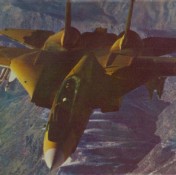Ukraine War, 22 November 2022: Air War Update, Part 3
Good morning everybody!
In the Part 1 and the Part 2 of this series of features, I’ve explained the ‘bare basics’ of how was the General Staff (GenStab) of the Armed Forces of the Soviet Union and then the Russian Federation (VSRF) conceptualising and defining requirements for capabilities of its future combat aircraft over the last 50–60 years: how did they define what they wanted their future aircraft to be capable of doing.
Moreover, I’ve explained major factors influencing the development — or, better expressed: degeneration — of the Soviet and then the Russian aviation industry over the last 30 years; how the Tolkachev treachery compromised the last generation of combat aircraft developed in the USSR already before this entered service, and then how Putin delivered a ‘coup de grace’ because of his drive to have all of the Russian aviation industry under his personal control for the purpose of extracting his cut.
That’s the ‘basics’: it’s defining the capabilities and qualities of the aircraft (and weaponry) manufactured by the industry.
The next question is: what are the Armed Forces of the Russian Federation doing with the resulting aircraft (and their weaponry)?
In this regards, there is a giant — repeat for emphasis: giant — difference between what the West thinks-, and tells its public to think about the capabilities of Soviet and Russian combat aircraft; and, what the Soviets and, more recently, the Russians actually can and intend to do with these. So much so, there are two entirely different (if not diametrically opposite) ‘depths of perception’. To explain this I need to go back into the history of the last 70 years. Don’t worry: it’s not going to take long. Of course, I’m perfectly aware that many are going to declare the following for ‘unimportant’ and whatever. My recommendation is always the same: do not read and you’re going to feel better.
From MiG-Hysteria…
Many youngsters are likely to consider it ‘silly’; those old enough to recall might disparage the following, and explain it away with about 2,746,239 different reasons (every single better than the previous one), but: just like there was a hysteria about the ‘Communist threat’ — best impersonated in the witch-hunts of the McCarthy-era in the USA of the early 1950s — in the Western public of the last 70 years there was a similar hysteria about Soviet combat aircraft. Should there be any doubts, mind the following few examples.
The Cold War merely began when, back in 1950, the Soviets took the West by surprise through the appearance of their MiG-15s in the skies of the Korean War. In turn, this prompted the West into daydreaming about ‘Soviets pressing into production and operational service thousands of aircraft based on Nazi-German designs, too’. No, I’m not exaggerating. Here a good example from the contemporary US press.
Only five years later, ‘some country there’ named Egypt ‘dared’ ordering MiG-15s: actually, it needed arms to defend itself from constant and murderous Israeli attacks. Imagine Mexican armed forces assaulting a police station in Nogales, Arizona, and slaughtering 20 police officers in their beds? …or Belarus flying its fighter jets over Gdansk, and provoking air combats over Malmö — and you’ve got the picture about what was going on. Don’t worry: the Israeli behaviour was explained away with ‘Arab terrorism’ — even if all the major Western governments (but especially that of the USA) knew that Israel was planning a land grab of multiple neighbouring countries even before it was officially established, and thus trying to provoke a new major war with its neighbours all through the 1950s. They knew that Cairo was demanding deliveries of — between others — British, and then US combat aircraft for self-defence, too.
That simply didn’t matter, just like it didn’t matter that all such requests were either embargoed or turned down: all that mattered was that, after being repeatedly turned down, Egyptian leader — Gamal Abdel Nasser — was declared for impersonation of Hitler and a villain, for — between others — ‘buying Soviet MiGs’. This, ‘automatically’, made him ‘slip within the Soviet sphere of influence’, indeed, it made entire Egypt a ‘Soviet puppet state’, and thus a free game.
(For those who are now going to explain me that Egypt was a ‘Soviet puppet state’: if at all, this happened much latter, and then because of another Israeli aggression, the June 1967 Arab-Israeli War, understated in the West as the ‘Six Days War’).
‘No way’ — and thus as soon as the Egyptian order for (between others) ‘MiGs’ became known, the British, French and Israelis set up and then launched an aggression on the country, aiming to topple Nasser’s government.
Ironically (humanity is full of ironies) the affair that was very much felt as a ‘Suez War’ in most of Egypt, became known as the ‘Suez Crisis of 1956’ in the West. And, it was ‘solved’ through the threat of US economic intervention against London and Paris: no, not because the USA have all of a sudden realised the truth, but because the administration in Washington was offended by the aggression on Egypt being launched short of elections in the USA.
Best of all is: the experience of that US intervention, combined with the (entirely unsubstantiated) threat of the Soviet leader Nikita Khrushchev, drove Britain and France into costly development of their own nuclear weapons — and the French then helping Israel do the same… and all of this because of ‘few Soviet MiGs’…
One could go on with such examples literally ‘forever’, because things didn’t change much over the next 10, 20, 30 and more years. Thus, let me add just one more, from the mid-1980s: at the time, both the administration of the US President Ronald Reagan and the Pentagon were ‘wetting’ themselves, something like three times a day, at a mere mention of the possibility of delivery of Soviet-made MiG-21s to Nicaragua. This was made equal to something like ‘Nicaraguan Sandinistas are already operating hundreds of these, and are short of invading Wichita, and Seattle, and Moon and Mars’….
Actually, Nicaragua got only a handful of SIAI-Marchetti SF.260s, and then from Libya, and without necessary spares, and the country was so poor, so exhausted by looting of the US-supported Somoza regime and foreign corporations, and then years of a murderous war against US-supported ‘Contras’, that it could barely make any use of them. However, Washington did as if this would mean ‘MiGs are already there’ and the USA are going to ‘lose the Third World War — before even starting it’.
….’Miraculously’, nobody came to the idea that, once Egypt did receive 100+ MiGs, in 1957–1958, it didn’t ‘promptly launch an aggression on Israel’. Even less did anybody care when, years later, dozens of these ‘ultra-dangerous’ MiGs were shot down in droves — and that by Western-made fighter jets — during ‘local wars’ in the Middle East or in South East Asia. That was explained away with ‘incompetence’ of their pilots…
….to Sukhoi-Fanboyism
Years later, the USSR lost the Cold War and then dissolved, but the ‘MiG hysteria’ just went on — this time in form of the ‘Su-27/Flanker-Fanboyism’. While the Tolkachev treachery remained well-hidden from the public for most of the 1990s and early 2000s, not only Western intelligence agencies but officers of Western armed forces were now in position to ‘openly’ study Soviet-made combat aircraft, and find out about all of their capabilities. Or the lack of the same: indeed, all about their weaknesses, too. Nevertheless, Russian combat aircraft — and particularly the ‘family’ of designs based on the Sukhoi Su-27 fighter-bomber — were hyped at every opportunity, and that by serious professionals and enthusiasts alike. The same was valid for other Russian weapons, especially S-300 SAM-systems and their derivatives, of course — and that although pilots of the US Air Force and allied air forces of NATO were training with help of manuals providing detailed insights into their capabilities already as of the late 1980s… i.e. although the capabilities of the same were well-known, ‘inside out’…
In turn, the Russian aviation industry was in deep trouble and in need of exports to remain afloat. That required plentiful of advertising.
…and the Russians like to talk about planning, even if — regularly — realising very little of that….
That, ladies and gentlemen, worked great — for both sides, the Russians and the West: it could be said that there was a mutual interest in hyping anything Russian-made. In the West, it secured funding for new armament and armed forces at the time of massive downsizing of the latter; in Russia, it secured funding for at least some research and development — or at least in support for exports of ‘latest’ versions of combat aircraft and armament, even at the times the VSRF could not afford either.
Henceforth, ‘Flanker’ (ASCC/NATO-reporting name for the Su-27-family) was hyped in countless articles in the specialised press, and video-games, while any kind of ‘idea’ for — for example — a new Su-27-variant, any kind of ‘idea’ for a new weapon for it, any kind of mere negotiations about the possibility of an export (whether of Su-27s or their derivatives, or any other kind of Russian weaponry) was ‘automatically’ (mis)declared into reality.
To name only a few resulting idiocies of recent years: Algeria has bought dozens of Su-32/34s, Iran bought 270 Su-27, and Turkey bought Su-57s… while US-made aircraft have ‘fought’ Flankers in dozens of video games taking place in Ukraine…
Above all, capabilities of Su-27-derivatives (see: Su-30, Su-34, Su-35 etc.) were presented as if the these would be deployed and operated by Western — especially NATO-member — air forces, which have presented their latest capabilities in quite a dramatic fashion during several ‘local wars’ of the 1990s and then 2000s.
….while, in reality, things were entirely different — especially so in Russia, i.e. in what since 2016–2017 is, officially, the Russian Air & Space Force. That’s going to be explained in the Part 4.




